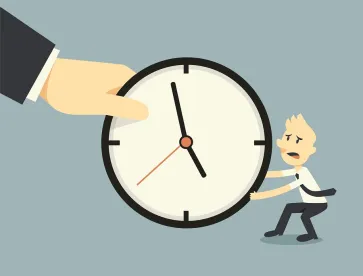Generally, the Fair Labor Standards Act (“FLSA”) requires employers to compensate their non-exempt employees for all time that they are required or allowed to perform work, regardless of where and when the work is done. However, an exception exists for small amounts of time that are otherwise compensable work time but challenging to record, otherwise known as the de minimis doctrine. Of course, the million-dollar question is how much time is considered de minimis. Unfortunately, there is no bright-line rule and the answer may differ under federal law and California law, or other states.
Federal Law
The Supreme Court first described the de minimis doctrine as “split-second absurdities” that “are not justified by the actualities of working conditions or by the policy of the Fair Labor Standards Act.” See Anderson v. Mt. Clemens Pottery Co., 328 U.S. 680, 691-93 (1946). Since Mt. Clemens, federal courts have generally analyzed three non-determinative factors to determine whether time is de minimis or compensable: (1) the practical difficulty the employer would face in recording the additional time; (2) the total amount of compensable time; and (3) the regularity of the additional work. See, e.g., Reich v. New York City Transit Authority, 45 F.3d 646, 652 (2d Cir. 1995); Lindow v. United States, 738 F.2d 1057, 1062-63 (9th Cir. 1984). While there is no bright-line rule as to how much time is or is not de minimis, many courts have held that less than ten minutes of working time is de minimis. See, e.g., Aguilar v. Mgmt & Training Corp., 948 F.3d 1270, 1284 (10th Cir. 2020); Lyons v. Conagra Foods Packaged Foods LLC, 899 F.3d 567, 584 (8th Cir. 2018).
The United States Department of Labor (“DOL”) has likewise recognized the de minimis principle, codifying the defense at 29 C.F.R. § 785.47, though cabining it to “where there are uncertain and indefinite periods of time involved of a few seconds or minutes duration, and where the failure to count such time is due to considerations justified by industrial realities.” The regulation further provides that “[a]n employer may not arbitrarily fail to count as hours worked any part, however small, of the employee’s fixed or regular working time or practically ascertainable period of time he is regularly required to spend on duties assigned to him.” The DOL has advised that the de minimis rule applies to the aggregate daily time for all activities for which an employee seeks compensation, not separately as to each discrete activity. See DOL Wage and Hour Advisory Memorandum No. 2006-2 (May 31, 2006), available at https://www.dol.gov/agencies/whd/field-assistance-bulletins/2006-2.
Common examples of time considered de minimis include:
-
The time spent turning off the lights and locking the door at the end of a shift
-
The time spent powering up or down a computer at work
-
The time spent checking in and out tools before working (two to five minutes in total).
California Law
In 2018, the California Supreme Court held in Troester v. Starbucks Corporation that California’s wage and hour laws do not fully align with the federal de minimis doctrine. 5 Cal. 5th 829 (2018). Specifically, in Troester, the court observed that the California labor laws are more protective than the federal de minimis rule in that California law requires employees to receive compensation for all hours worked or any work beyond eight hours a day. The court ultimately rejected the application of the de minimis rule to plaintiffs with daily post-closing activities ranging from 4 to 10 minutes each shift. In so holding, the court emphasized that such activities took minutes each shift and occurred regularly.
In the wake of Troester, some have suggested the de minimis doctrine in California is dead or that any time exceeding a minute is compensable in California. However, neither view is supported. Notably, the California Supreme Court noted several examples where the de minimis defense could apply, such as “paperwork involving a minute or less of an employee’s time” or “an employee reading an e-mail notification of a shift change during off-work hours.” And, Troester left open “whether there are circumstances where compensable time is so minute or irregular that it is unreasonable to expect the time to be recorded.” Indeed, according to the Ninth Circuit, the rule in Troester “does not require employers to account for split-second absurdities and might not apply in cases where work is so irregular that it is unreasonable to expect the time to be recorded.” Rodriguez v. Nike Retail Services, Inc., 928 F.3d 810, 818 (9th Cir. 2019) (internal citations and quotations omitted).
How to Avoid Wage and Hour Claims
Whether operating in California or elsewhere, employers can mitigate the risk of claims for unpaid wages and overtime by taking the following steps:
-
Determining whether non-exempt employees regularly engage in any pre- or post-shift activities that are not currently being recorded;
-
Selecting appropriate time-keeping software that can be accessed remotely on smartphones, tablets, or other devices;
-
Adopting official policies prohibiting off-the-clock work and requiring non-exempt employees to report any work;
-
Instructing non-exempt employees to notify management of any time not captured in their clock in/clock out times, no matter how small;
-
Structuring work so that employees do not work before or after clocking in/out; and
-
Limiting pre- and post-shift communications with non-exempt employees.



 />i
/>i

